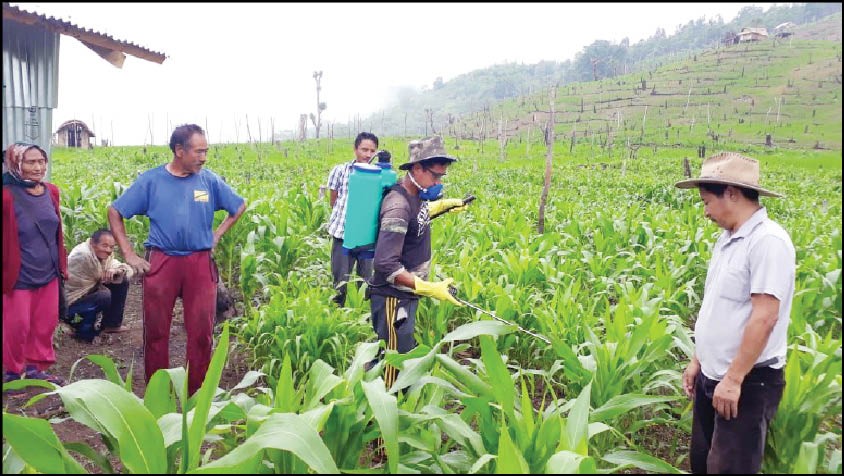Eco friendly pesticides sprayed on maize crops at Tseminyu by field workers of Department of Agriculture in an effort to contain the threat of Fall Army Worm recently. (Photo courtesy: Department of Agriculture)

DIMAPUR, JUNE 28 (MExN): Nagaland Government has stated that the threat posed by Fall Army Worm (FAW), a pest found to attack maize and other crops have largely been contained.
However, a clearer picture will emerge over the next few weeks with the flowering of maize plants to ascertain if the infestation by the deadly pests could be completely contained, a press statement issued by Ben Yanthan, Director, Department of Agriculture informed on Friday.
FAW, a caterpillar that got the name because it invades croplands in droves, much like an army, has rapidly spread across Nagaland and other Northeastern states since it was detected in southern India late last year.
The areas found infested by FAW in Nagaland include Kohima, Chiephobozou, Tseminyu, Phek, Chozuba, Meluri, Zunheboto, Akuluto, Aghunato, Satakha, Pughoboto, Mokokchung, Tuli, Mangkolemba, Peren, Tening, Kiphire, Pungro, Tuensang, Shamator, Longkhim, Dimapur, Wokha and Baghty. Control operations have been executed in these areas.
Out of 63849 hectares - the total area under maize cultivation, 4470.17 hectares were found infested by FAW. Only two villages in Tuensang that falls under the organic cluster (about 20 Ha) has been affected and recommendation for control was Azadirachtin 1500 ppm and Metarhizium Anisopliae. According to latest data, the pest is under control in these areas.
The department and various agencies have been successful in restraining the further spread of FAW infestation to new areas.
G. Kaito Aye, Minister for Agriculture and Cooperation, has been himself monitoring the efforts to contain the Fall Army Worm infestation, to ensure Nagaland's organic advantage is not lost. He has also been overseeing the smooth coordination in the State among all agencies that are involved countrywide in the fight against the FAW pest, the press statement acknowledged.
Close on the heels of the invasion of the crop damaging pest in neighboring Mizoram and Manipur, the FAW infestation was first reported from Sakhabama village under Kohima district on the May 9, 2019. The infestation was in the early part of the second cycle, with the damage percentage of about 20-35% which required chemical control.
More reports of infestation arrived after the department corresponded officially with the KVKs (Krishi Vigyan Kendras), ATMA (Agriculture Technology Management Agency), CIPMC (Central Integrated Pest Management Centre), Districts and Sub-Divisional Agriculture Officers.
With the threat looming large and aware of the devastation caused in the neighbouring states, the department set about procuring inputs for control of fall army worm on a war footing even as pest scouting, identification of infested areas and training for farmers were initiated. The focus was on containing the infestation of the fall army worm without causing harm to the environment.
Bio-control measures and eco-friendly pesticides were employed for fighting the pests as per the Indian Council of Agricultural Research (ICAR) recommendation. Another major concern was to protect the organic clusters in Nagaland from being exposed to harmful pesticides in the process of containing the infestation.
The department procured Azadirachtin 1500 ppm for prophylaxis (treatment given to prevent disease), Entomopathogenic fungi (fungi that can act as a parasite of insects and kills or seriously disables them), Metarhizium anisopliae for lower intensity areas, Emamectin benzoate 5% SG for highly infested areas, sprayers, protective gears.
Pheromone trap was also used in all the FAW infested areas. This trap is used for attracting the male FAW moths to control further breeding and increase of FAW population.
Surveillance and monitoring is still in progress and will continue till harvest. Monitoring and surveillance are being conducted in all maize growing areas by departmental officials, extension personnel, KVKs, CIPMC, ATMA functionaries and progressive farmers, the press statement said.


